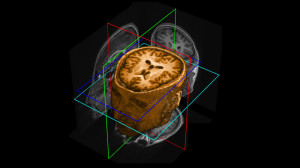 New results reported by Medical Research Council Cognition and Brain Sciences Unit and University of Cambridge researchers raise interesting questions about possible benefits of left-handedness. Approximately 1 in 10 of us are left-handed. Whilst the brains of left- and right- handed people are generally organized along similar lines, one reported difference is in a Ventral Attention Network (VAN). In right-handers this is mainly in the right side of the brain whilst in left handers it is more balanced 1. The VAN is important because brain damage in this region is linked with a condition known as Unilateral Spatial Neglect 2. Patients with spatial neglect find it difficult to notice information from one side of space and may ignore people approaching from that side, eat food from only one side of their plates or dress only one side of their bodies. Stroke, an interruption to the blood supply that affects one or other side of the brain, is the main cause of Spatial Neglect and the leading cause of long-term disability.
New results reported by Medical Research Council Cognition and Brain Sciences Unit and University of Cambridge researchers raise interesting questions about possible benefits of left-handedness. Approximately 1 in 10 of us are left-handed. Whilst the brains of left- and right- handed people are generally organized along similar lines, one reported difference is in a Ventral Attention Network (VAN). In right-handers this is mainly in the right side of the brain whilst in left handers it is more balanced 1. The VAN is important because brain damage in this region is linked with a condition known as Unilateral Spatial Neglect 2. Patients with spatial neglect find it difficult to notice information from one side of space and may ignore people approaching from that side, eat food from only one side of their plates or dress only one side of their bodies. Stroke, an interruption to the blood supply that affects one or other side of the brain, is the main cause of Spatial Neglect and the leading cause of long-term disability.
 Corinne Bareham, the first author of the paper published this week in Scientific Reports, comments – We know that Spatial Neglect is much more persistent after damage to the right side of the brain. If left-handed people have a more balanced Ventral Attention Network with parts of it on both sides of the brain, potentially this makes them less vulnerable to Spatial Neglect. Its hard to tell whether this is the case from existing clinical studies because left-handed patients are often excluded so that the ‘normal’ (i.e. right handed) pattern is clearer or their results are not reported separately. Testing this theory would require recruiting many hundreds of stroke patients so that there were enough left-handed patients to detect a difference. Another approach was to look at something that looks like Spatial Neglect that happens to most of us at least once a day. Previously we have shown that as perfectly healthy people are falling asleep they show a marked tendency to ignore information on the left – just like patients with neglect after right sided brain damage3. Because neglect is more severe when patients are drowsy, we think we might be looking at an exaggeration of a pattern we all show. In the current study we asked left-handed healthy volunteers to relax with their eyes closed and to tell us whether each of a series of tones had occurred to their left or right. Unlike right-handers, who did exactly the same procedure, the left-handers showed no tendency to ignore misjudge tones from the left, if anything the reverse. Whilst further work with patients is required, this is our first indication that brain differences related to left-handedness may give people an advantage in resisting some of the effects of stroke.
Corinne Bareham, the first author of the paper published this week in Scientific Reports, comments – We know that Spatial Neglect is much more persistent after damage to the right side of the brain. If left-handed people have a more balanced Ventral Attention Network with parts of it on both sides of the brain, potentially this makes them less vulnerable to Spatial Neglect. Its hard to tell whether this is the case from existing clinical studies because left-handed patients are often excluded so that the ‘normal’ (i.e. right handed) pattern is clearer or their results are not reported separately. Testing this theory would require recruiting many hundreds of stroke patients so that there were enough left-handed patients to detect a difference. Another approach was to look at something that looks like Spatial Neglect that happens to most of us at least once a day. Previously we have shown that as perfectly healthy people are falling asleep they show a marked tendency to ignore information on the left – just like patients with neglect after right sided brain damage3. Because neglect is more severe when patients are drowsy, we think we might be looking at an exaggeration of a pattern we all show. In the current study we asked left-handed healthy volunteers to relax with their eyes closed and to tell us whether each of a series of tones had occurred to their left or right. Unlike right-handers, who did exactly the same procedure, the left-handers showed no tendency to ignore misjudge tones from the left, if anything the reverse. Whilst further work with patients is required, this is our first indication that brain differences related to left-handedness may give people an advantage in resisting some of the effects of stroke.
1Liu, H., Stufflebeam, S. M., Sepulcre, J., Hedden, T. & Buckner, R. L. Evidence from intrinsic activity that asymmetry of the human brain is controlled by multiple factors. Proc Natl Acad Sci U S A 106, 20499-20503, doi:10.1073/pnas.0908073106 (2009).
2Corbetta, M. & Shulman, G. L. Spatial neglect and attention networks. Annu Rev Neurosci 34, 569-599, doi:10.1146/annurev-neuro-061010-113731 (2011).
3Bareham, C. A., Manly, T., Pustovaya, O. V., Scott, S. K. & Bekinschtein, T. A. Losing the left side of the world: rightward shift in human spatial attention with sleep onset. Scientific Reports 4, 5092, doi:10.1038/srep05092 (2014)

 MRC Cognition and Brain Sciences Unit
MRC Cognition and Brain Sciences Unit


